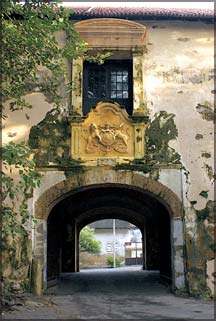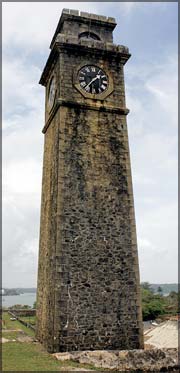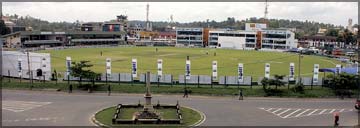|

UNESCO World Heritage Site:
Call of Galle
Jayanthi LIYANAGE
The Fort of Galle is the only living town within a fort in Sri Lanka
in which people live within its ramparts. It was built during the Dutch
occupation of maritime provinces in Ceylon (1658 AD - 1796 AD) on behalf
of Holland as executed by the Dutch East Indian Company (Vereenidge
Oost-Indische Compagnie - VOC), a commercial company which had the right
to maintain armies, build forts, plant colonies, to make war or peace,
arrange treaties or coin money, informs the book "The Sinhalese have met
the modernists" written by Susan W. Gunasekera.
|

The Dutch coat of arms or the monogram of the VOC, inscribed
on the inside arch of the old main gate to the Fort |
|

Deloraine Brohier |
The Fort of Galle was built on the orders of the Viceroy Mathias de
Albuquerque in the year 1589 where the Dutch Black (Zwarts) bastion now
stands and used as Police quarters, narrates Percy Colin-Thome in his
memoir to E.F.C. Ludowyk's book "Those Long Afternoons - childhood in
colonial Ceylon." The popular derivation of the name Galle is from the
Sinhalese gala, a rock, says Colin Thome. "Magalle is a contracted form
of maha-gala, the big rock. Another derivation is gaala, a cattle pen.
The old cattle pen of Rawana is supposed to have been the Victoria Park.
It was called Pattiawela and Pattiapalama is the name of the bridge
close to the Railway Station. The Portuguese struck by the similarity in
the sound of the word gala with their word gallo (gallus, a cock),
seemed to have connected the word with the bird, and the Dutch, who
succeeded them in the middle of the 17th century, kept up the idea by
adopting the cock as a charge on the arms which they assigned to the
town."
The arms depict a cock standing on a rock. The building in Galle
which used to be the Dutch Commandeur's Residence has the symbol of
Galle, the cock, carved on its front door post.
|

Former lock-up room of prisoners. Pix: Mahinda Vithanachchi |
The Daily News sought the memories of Deloraine Brohier, former
President of the Dutch Burgher Union and former President of Sri Lanka -
Netherlands Association, who lived in Galle, to unearth historical facts
about the Fort. She is the daughter of the late Dr. R.L. Brohier who
worked in the Surveyors' Department and authored books "Seeing Ceylon"
(1965) and "Discovering Ceylon" (1973). In 2002, she was conferred the
honour of the Knight of the Order of Oranje-Nassau, bestowed on the
occasion of the official birthday of Her Majesty the Queen of the
Netherlands, Queen Beatrix.
Seeing Ceylon
"During Portuguese rule, they had only a small fort which overlooked
the harbour," said Ms. Brohier, consulting her father's book "Seeing
Ceylon". "It was just a battlement and a few churches and monasteries in
the interior. What you see today is what was built by the Dutch who were
engineers and builders. They built more solidly because architectural
designs and military skills had advanced by the time the Dutch came."
From the esplanade, the sun, moon and star bastions forming the front
line of the line of defences can be seen. A bastion is a point of the
defences from which the rulers could defend in the event of being
attacked.
"Whereas history holds that the Portuguese discovered what came to be
called Point-de-Galle, the credit must go to the Dutch for having made
it. They decidedly gave the town a character which the fret and wear of
160 years have barely touched, and the good sense of the people who
followed them has let alone," states "Seeing Ceylon".
"The Dutch being commercial-minded traders and business people took
the fringe of Ceylon which was maritime provinces and they did not
occupy the whole of Ceylon, unlike the British," explains Ms. Brohier.
To guard the island from the French and the British seeking settlements
in Asia, they ringed the walled town of Galle with ten bastions.
|

The clock tower |
Ludowyk writes that five landmarks crowned the Fort: clock tower,
flagstaff, windmill, lighthouse and the bastion of the Police station.
The clock tower had been built by a Sinhalese philanthropist in memory
of Dr.P.D.A. Anthonisz, a well-known Burgher doctor who was the
Principal of the Medical College and a member of the Executive Council.
"Seeing Ceylon" also recalls that during the governance of Governor
Frederick North in 1800, a design was formed to destroy all the
fortifications of the Fort except the bastions which immediately guard
the entrance into the harbour. But happily, this was not done other than
to clear a distance of 700 yards on the land side of the ramparts on the
orders of Governor North. Later, the preservation of the Galle ramparts
became a governmental concern and the Fort was proclaimed an
Archaeological Reserve.
"In early British times, Colombo did not have a harbour and Galle
harbour was the hub of sailing ships. The ships coming round the Cape of
Good Hope would naturally stop at Galle.
Trade
The Chinese ships would stop at the watering point in Roomassala, the
hill opposite the Fort," says Ms. Brohier. Traders and sight seers from
different parts of Europe, Australia, India and the Far East patronised
the shops of Sinhala and Muslim vendors of delicate embroideries, Galle
lace, silver ornaments, precious stones, tortoise shell, ebony and
ivory. Those days, passengers paid in gold. "When mechanised ships came,
they found a band of rocks across the entrance to the harbour. During
the British period, Colombo developed as an administration head quarters
from which roads and railways radiated and an artificial harbour was
built in Colombo. Galle harbour faded out of popularity and Galle became
the sleepy town it is today."
|

The Galle cricket stadium. |
"Seeing Ceylon" points out that the distinctive character which the
Dutch engineers bestowed on Galle has not changed much. "The roads are
straight and narrow. From above, they lie like dusty rulers forming a
grid in a flat landscape reclaimed from the sea. Some of them carry
quaint old world names such as Leyn-Baan Street (rope walk), Great and
Small Moderabaay Streets (mud-bay) and Lighthouse Street which had an
older name, Zeeburg Street." In the old houses of Galle, a variety of
fan lights and ornamental lintels over window or door ways indicate how
the Dutch craftsmen dispelled the sameness of the domestic architecture
of the period. The dominant architectural feature they used in large
buildings was the gable.
The windmill was part of a water-borne sewage system in town planning
which was considered extraordinary.
The greater part of the walled town being below the level of the sea,
the Dutch colonial engineer harnessed the tide at its ebb to carry its
refuse away. "Little was known of the vast network of brick-lined drains
which lay from six to twelve feet below normal ground level until an
epidemic of bubonic plague in 1922, compelled attempts to segregate and
exterminate the enormous rat population in the sewers," states "Seeing
Ceylon". "The sewers, despite decay, together with auxiliary honeycomb
of house connections, function to this day, to carry off water used for
domestic purposes. The tide continues to run in and out."
Religion
"The Dutch was very conscious of health and maintenance of the
cities, flushing of drains and collection of garbage," says Ms. Brohier.
A Protestant Church, known as Groote Kerk church, a Dutch Reformed
Church, had been built in Galle, on the site of the Capuchin Convent of
Portuguese times. Nearly 200 years old, it is today superseded by the
Christian Reformed Church. "The Dutch were Calvinists and very
democratic in their outlook in church worship."
The New Oriental Hotel owned by a Burgher family named Ephraums,
coming from Amsterdam, has now been bought by a foreign hotelier and
turned into a luxury hotel known as Amangalla.
The premises was the barracks of British Officers which Ephraums
converted into a hotel after purchasing it. The esplanade of Galle, now
the venue of an international stadium where the Cricket Match between
New Zealand and Sri Lanka is played, is surrounded by relics from its
Dutch occupation, providing a stimulating diversion to both the sight
seer and the historian.
(Our thanks go to T.H. Nelson de Silva of Department of Archaeology,
Galle, who assisted our photojournalist Mahinda Vithanachchi in locating
historical sites for photography.)
The popular derivation of the name Galle is
from the Sinhalese gala, a rock, says Colin Thome. Magalle is a
contracted form of maha-gala, the big rock. Another derivation is gaala,
a cattle pen. The old cattle pen of Rawana is supposed to have been the
Victoria Park
|



